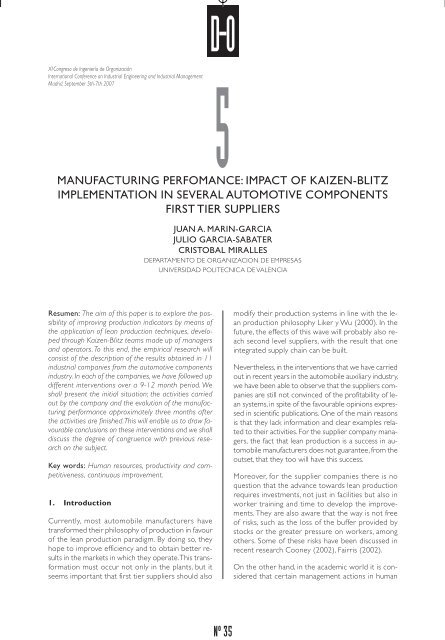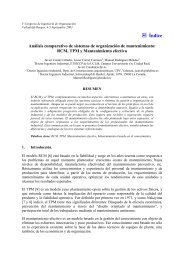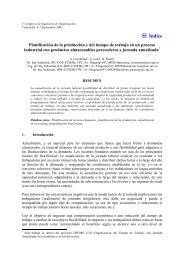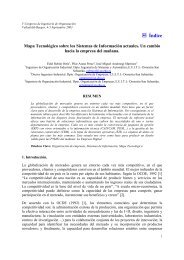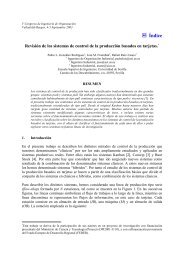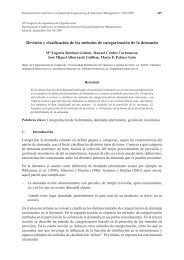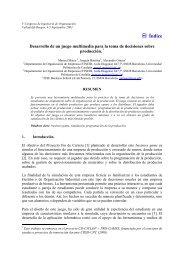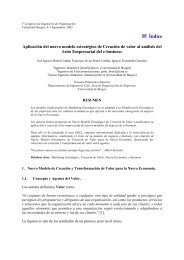entre empr<strong>es</strong>as no reduzcan la competencia. Por tanto,<strong>es</strong> d<strong>es</strong>cartable que las consejerías cruzadas tengancomo motivación la creación de monopolios. Salvo<strong>es</strong>ta peculiaridad, el modelo de organizacióneconómica <strong>es</strong>pañol tiene las características propiasde un modelo continental, en el que no son los bancos,sino las empr<strong>es</strong>as privatizadas, quien<strong>es</strong> tienen lamayor centralidad en la red. Comparando <strong>es</strong>tos r<strong>es</strong>ultadoscon los de Aguilera, cabe concluir que losbancos <strong>es</strong>pañol<strong>es</strong> abandonan progr<strong>es</strong>ivamente elmodelo de banco universal, para centrarse en la actividadcomercial. Pero no hay que olvidar que los r<strong>es</strong>ultadosde <strong>es</strong>te <strong>es</strong>tudio son una fotografía de unmodelo en evolución. En el futuro, cabe <strong>es</strong>perar unacentralidad aún menor de las entidad<strong>es</strong> bancarias (LaCaixa, única entidad bancaria con un grupo industrialvisible en la red, ha manif<strong>es</strong>tado su intención de vendersus participacion<strong>es</strong> industrial<strong>es</strong> en breve), y unaevolución aún incierta, pero dinámica, del sectorenergético. De la evolución futura de las empr<strong>es</strong>asprivatizadas depende que España adopte finalmenteun modelo anglosajón de organización económica, opersistan trazas del actual modelo continental.7. ReferenciasAGUILERA, R. V. (1998). Directorship Interlocks in aComparative Perspective: the Case of Spain, EuropeanSociological Review, Vol. 14, No. 4, pp. 319-342.ASHAR, H., y SHAPIRO, J. Z. (1988). Measuring Centrality– A Note on Hackman R<strong>es</strong>ource-AllocationTheory, Administrative Science Quarterly, Vol. 33,No. 2, pp. 275-283.AZOFRA, V., y SANTAMARIA, M. (2004). El gobiernode las cajas de ahorro <strong>es</strong>pañolas. Universia Busin<strong>es</strong>sReview, No. 2, pp. 48-59.BORGATTI S. P.; EVERETT, M. G., y FREEMAN, L.C.(2002). Ucinet for Windows: Software for Social NetworkAnalysis.BYRD, D. T., y MIZRUCHI, M. S. (2005). Bankers onthe Board and the Debt Ratio of Firms, Journal ofcorporate finance, Vol. 11, Nos.1-2, pp. 129-173.DAVIS, G. F. (1991). The Agents without Principl<strong>es</strong> –The Spread of the Poison Pill through the IntercorporateNetwork, Administrative Science Quarterly,Vol. 36, No. 4, pp. 583-613.DIMAGGIO, P. J., y POWELL, W. W. (1983). The IronCage Revisited: Institutional Isomorphism and collectiverationality in organizational fields, AmericanSociological Review, Vol. 48, pp. 147-160.FREEMAN, L. C. (1979). Centrality in Social Networks:Conceptual Clarification, Social Networks,Vol. 1, No. 3, pp. 215-239FREEMAN, L. C.; BORGATTI, S. P., y WHITE, D. R.(1991). Centrality in Valued Graphs: A Measure ofBetweenn<strong>es</strong>s Based on Network Flow, Social Networks,Vol. 13, No. 1, pp. 141-154.HAUNSCHILD, P. R. (1993). Interorganizational Imitation– The Impact of Interlocks on CorporateAcquisition Activity, Administrative Science Quarterly,Vol. 38, No. 4, pp. 564-592.HAUNSCHILD, P. R., y BECKMAN, C. M. (1998).When do Interlocks Matter?: Alternate Sourc<strong>es</strong> ofInformation and Interlock Influence, AdministrativeScience Quarterly, Vol. 43, No. 4, pp. 815-844.MARSDEN, P. V. (2002). Egocentric and SociocentricMeasur<strong>es</strong> of Network Centrality, Social Networks,Vol. 24, No. 4, pp. 407-422.MCQUITTY, LL., y CLARK, J. A. (1968). Clusters fromiterative intercolumnar correlation analysis, Educationaland psychological measurement, Vol. 28,No. 2, pp. 211 y ss.MINTZ, B., y SCHWARTZ, M. (1981). Interlocking directorat<strong>es</strong>and inter<strong>es</strong>t group formation, AmericanSociological Review, Vol. 46, No. 6, pp. 851-869.MIZRUCHI, M. S. (1996). What Do Interlocks Do? AnAnalysis, Critique, and Ass<strong>es</strong>sment of R<strong>es</strong>earch onInterlocking Directorat<strong>es</strong>, Annual Review of Sociology,Vol. 22, pp. 271-298.O’HAGAN, S. B., y GREEN, M. B. (2004). CorporateKnowledge Transfer via Interlocking Directorat<strong>es</strong>:a Network Analysis Approach, Geoforum, Vol. 35,pp. 127-139.PENNINGS, J. M. (1980). Interlocking Directorat<strong>es</strong>: Originsand Consequenc<strong>es</strong> of Connections Among Organizations’Boards of Directors, John Wiley and Sons, Ltd.PROWSE, S. (1994). Corporate governance in an internationalperspective: A survey of corporatecontrol mechanisms among large firms in the unitedstat<strong>es</strong>, the United Kingdom, Japan and Germany.Economic Papers, Vol. 41. Bank of InternationalSettlements.SCHWARTZ, J. E. (1977). An Examination of CON-COR and Related Methods for Blocking SociometricData, Sociological Methodology, Vol. 8, pp.255-282.SHLEIFER, A. Y., y VISHNY, R. W. (1997). A Survey ofCorporate Governance, Journal of Finance, Vol. 52,No. 2, pp. 737-783.SCOTT, J. (2000). Social Network Analysis: A Handbook,London: SAGE Publications.USEEM, M. (1984). The Inner Circle, Oxford UniversityPr<strong>es</strong>s.ZAHRA, S. A., y PEARCE II, J. A. (1989). Boards of directorsand corporate financial performance: A reviewand integrative model, Journal of Management,vol. 15, No. 2, pp. 291-334.ZAJAC, E. J. (1988). Interlocking Directorat<strong>es</strong> as anInterorganizational Strategy – A T<strong>es</strong>t of Critical Assumptions,Academy of Management Journal, Vol.31, No. 2, pp. 428-438.36
D-O5MANUFACTURING PERFOMANCE: IMPACT OF KAIZEN-BLITZIMPLEMENTATION IN SEVERAL AUTOMOTIVE COMPONENTSFIRST TIER SUPPLIERSXI Congr<strong>es</strong>o de Ingeniería de OrganizaciónInternational Conference on Industrial Engineering and Industrial ManagementMadrid. September 5th-7th 2007JUAN A. MARIN-GARCIAJULIO GARCIA-SABATERCRISTOBAL MIRALLESDEPARTAMENTO DE ORGANIZACION DE EMPRESASUNIVERSIDAD POLITECNICA DE VALENCIAR<strong>es</strong>umen: The aim of this paper is to explore the possibilityof improving production indicators by means ofthe application of lean production techniqu<strong>es</strong>, developedthrough Kaizen-Blitz teams made up of managersand operators. To this end, the empirical r<strong>es</strong>earch willconsist of the d<strong>es</strong>cription of the r<strong>es</strong>ults obtained in 11industrial compani<strong>es</strong> from the automotive componentsindustry. In each of the compani<strong>es</strong>, we have followed updifferent interventions over a 9-12 month period. W<strong>es</strong>hall pr<strong>es</strong>ent the initial situation; the activiti<strong>es</strong> carriedout by the company and the evolution of the manufacturingperformance approximately three months afterthe activiti<strong>es</strong> are finished. This will enable us to draw favourableconclusions on th<strong>es</strong>e interventions and we shalldiscuss the degree of congruence with previous r<strong>es</strong>earchon the subject.Key words: Human r<strong>es</strong>ourc<strong>es</strong>, productivity and competitiven<strong>es</strong>s,continuous improvement.1. IntroductionCurrently, most automobile manufacturers havetransformed their philosophy of production in favourof the lean production paradigm. By doing so, theyhope to improve efficiency and to obtain better r<strong>es</strong>ultsin the markets in which they operate. This transformationmust occur not only in the plants, but itseems important that first tier suppliers should alsomodify their production systems in line with the leanproduction philosophy Liker y Wu (2000). In thefuture, the effects of this wave will probably also reachsecond level suppliers, with the r<strong>es</strong>ult that oneintegrated supply chain can be built.Neverthel<strong>es</strong>s, in the interventions that we have carriedout in recent years in the automobile auxiliary industry,we have been able to observe that the suppliers compani<strong>es</strong>are still not convinced of the profitability of leansystems, in spite of the favourable opinions expr<strong>es</strong>sedin scientific publications. One of the main reasonsis that they lack information and clear exampl<strong>es</strong> relatedto their activiti<strong>es</strong>. For the supplier company managers,the fact that lean production is a succ<strong>es</strong>s in automobilemanufacturers do<strong>es</strong> not guarantee, from theoutset, that they too will have this succ<strong>es</strong>s.Moreover, for the supplier compani<strong>es</strong> there is noqu<strong>es</strong>tion that the advance towards lean productionrequir<strong>es</strong> inv<strong>es</strong>tments, not just in faciliti<strong>es</strong> but also inworker training and time to develop the improvements.They are also aware that the way is not freeof risks, such as the loss of the buffer provided bystocks or the greater pr<strong>es</strong>sure on workers, amongothers. Some of th<strong>es</strong>e risks have been discussed inrecent r<strong>es</strong>earch Cooney (2002), Fairris (2002).On the other hand, in the academic world it is consideredthat certain management actions in humanNº 35
- Page 1: POLITÉCNICANÚMERO ESPECIALXI Cong
- Page 4 and 5: mayor difusión y visibilidad de la
- Page 7: Nº 35D-O1INTEGRACION DE UN SIG CON
- Page 10 and 11: Figura 3Estructura y principales co
- Page 12 and 13: Tabla 1Análisis VRP implementadosA
- Page 14 and 15: para casos concretos. Periódicamen
- Page 16 and 17: de determinar en qué municipio col
- Page 18 and 19: Tabla 3Definición de las variables
- Page 20 and 21: Figura 3Individuo (izda.) y método
- Page 22 and 23: los anteriores dada la dificultad d
- Page 24 and 25: — Si un puente-grúa llega antes
- Page 26 and 27: Una secuencia cíclica, definida po
- Page 28 and 29: Tabla 1Valores medios de tiempo de
- Page 30 and 31: D-O4LAS RELACIONES ENTRE LAS EMPRES
- Page 32 and 33: Además, el círculo social en el q
- Page 34 and 35: Tabla 3Resultados de la aplicación
- Page 38 and 39: esources, such as training, teamwor
- Page 40 and 41: 3.2. MeasuresAll the companies rece
- Page 42 and 43: arly 5% (setting out from levels ov
- Page 44 and 45: industry International Journal of O
- Page 46 and 47: de vencimiento. De acuerdo con Koul
- Page 48 and 49: una definición única. A continuac
- Page 50 and 51: Tabla 3Tiempos medios, en segundos,
- Page 52 and 53: D-O7LEAN PRODUCTION IMPLEMENTATION:
- Page 54 and 55: 56 Egyptian LP implementers and 38
- Page 56 and 57: Figure 1Main strategic objetives (L
- Page 58 and 59: 80%70%60%50%40%30%20%10%0%Figure 4C
- Page 60 and 61: Another very interesting result is
- Page 62 and 63: se produzcan situaciones no deseabl
- Page 64 and 65: el trayecto HRST250, definido para
- Page 66 and 67: Sujeto a:Restricciones [1] [2]…[1
- Page 68 and 69: MOUDANI, W., y MORA-CAMINO, F. A dy
- Page 70 and 71: Papadimitriou and Kanellakis (1980)
- Page 72 and 73: which may result in a relatively be
- Page 74 and 75: fraction, see Figure 4b (crossover-
- Page 76 and 77: Table 4Solution for the semi dynami
- Page 78 and 79: 8. ReferencesAPT, K. (2003). Princi
- Page 80 and 81: jetivo es analizar el vínculo exis
- Page 82 and 83: Adicionalmente, una relación entre
- Page 84 and 85: Figura 2Relaciones presentes en la
- Page 86 and 87:
Figura 4Valoración en la muestra d
- Page 88 and 89:
Nº 35D-O11MATHEMATICAL PROGRAMMING
- Page 90 and 91:
3.4. ConstraintsThe following const
- Page 92 and 93:
a PC at 1.83 GHz with 1 GB of RAM m
- Page 94 and 95:
Table 2Time differences between tim
- Page 96 and 97:
D-O12PATENTALAVA. DINÁMICA DE LAS
- Page 98 and 99:
Figura 2Evolución de las solicitud
- Page 100 and 101:
Figura 5Clusters tecnológicos en e
- Page 102 and 103:
cia un cambio en lo que podíamos d
- Page 104 and 105:
Figura 1Esquema de tecnologías alt
- Page 106 and 107:
tre otros, el coste de arranque de
- Page 108 and 109:
5.2. Construcción de las cuentas d
- Page 110 and 111:
D-O14PLANIFICACIÓN DEL TIEMPO DE T
- Page 112 and 113:
4. ModeloAunque todos los trabajado
- Page 114 and 115:
[12] impone que si la variable cl t
- Page 116 and 117:
Nº 35D-O15TRANSFERENCIA TECNOLÓGI
- Page 118 and 119:
de robótica y producción. Por una
- Page 120 and 121:
ien la diferencia no aparece signif
- Page 122 and 123:
presas es la siguiente (todos con p
- Page 124 and 125:
SANTORO, M. D., y GOPALAKRISHNAN, S
- Page 126 and 127:
⎧ ⎪⎪⎪⎪⎨⎪⎪⎪⎪⎩
- Page 128 and 129:
Substituting in the previous expres
- Page 130 and 131:
8.0007.0006.0005.0004.0003.0002.000
- Page 132:
POLITÉCNICAPROGRAMAS MASTER• Adm


